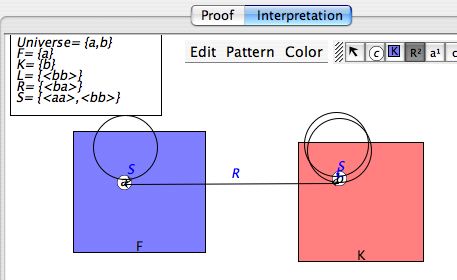
6/20/07
To understand how the various restrictions on the quantificational rules work to exclude certain kinds of invalid inferences
Bergmann[2004] The Logic Book Section 10.1
If a derivation contains a line of the form
n (∀<variable>)<scope> <any justification>
then a line of the form
<<scope>[<constant>/<variable>]> 'n ∀E'
may be added to the derivation. There are no restrictions on this rule.
If a derivation contains a line of the form
n. <<scope>[<constant>/<variable>]> <any justification>
then a line of the form
(∀<variable>)<scope> 'n ∀I'
may be added to the derivation, provided that
a) the <constant> does not occur in the <assumptions> of the formula that is generalized (the formula of line n), and
b) the <constant> does not occur in (∀<variable>)<scope>.
If restriction (a) was not there, the rule would permit inferences like Fa ∴ (∀y)Fy thus
1
Fa Ass 2
(∀y)Fy ????
(and this inference, perhaps 'Arthur is friendly, therefore Everyone is friendly', is invalid, as we show in the Exercises below).
If restriction (b) was not there, the rule would permit inferences like (∀y)Lyy ∴ (∀x)Lxa thus
1
(∀y)Lyy Ass 2
Laa 1 ∀E 3
(∀x)Lxa 2 ???
(and this inference, perhaps 'Everyone loves him or herself, therefore Everyone loves Arthur', is invalid, also shown below).
If a derivation contains a line of the form
n. <assumptions> (∃<variable>)(<scope>) <any justification>
and a line of the form
k. <assumptions+ <scope[<constant>/<variable>]>> <formula> <any justification>
and
the constant <constant> does not occur (a) in ∃<variable>)(<scope>) , (b) in any of the <assumptions> of line k except the additional assumption <scope[<constant>/<variable>]>, or (c) in the formula <formula>
then a line of the form
<next line number> <assumptions> <formula> 'k ∃I'
may be added to the derivation.
Roughly what the restrictions are there to prevent is the following. If we have derived an existential formula, say (∃x)Fx, which might be the symbolization of 'Something is F' we can certainly imagine that the principal thing that is F has a name, say 'a', in which case Fa holds ie 'a is F'. But now we have to be careful, because we usually use constants like 'a' to symbolize proper names like 'Arthur' and it certainly does not follow from 'Something is F' that 'Arthur is F'. The naming constant 'a' here has to be, in a manner of speaking, without other properties; it has just to be a temporary bland featureless identification of the thing that is F. If 'a' is already in use in the proof, perhaps Ga is a premise, then the potential exists for mischief for if we infer Fa from (∃x)Fx then we are assuming that the thing which is F is also the one that is G (and this does not follow). The restrictions keep all this in order.
If restriction (a) was not there, the rule would permit inferences like (∃x)Lxx ∴ (∃x)Lxa thus
1
(∃x)Lxx Ass 2
Laa Ass 3
(∃y)Lya 2 ∃I
4
(∃y)Lya ????
This inference might be 'Someone loves him or herself, therefore, someone loves Arthur'. It is invalid.
If restriction (b) was not there, the rule would permit inferences like Fa, (∃x)Kx∴ (∃y)(Fy&Ky) thus
1
Fa Ass 2
(∃x)Kx Ass 3
Ka Ass 4
Fa&Ka 1,3 &I 5
(∃x)(Fx&Kx) 4∃I
6
(∃x)(Fx&Kx) ????
1
Fa Ass 2
(∀y)Fy ????
This inference might be 'Arthur is friendly, Someone is kind, therefore, Someone is friendly and kind', and it is invalid.
If restriction (c) was not there, the rule would permit inferences like (∃x)Lxa∴ (∃y)Lyy thus
1
(∃x)Lxa Ass 2
Laa Ass 3
(∃y)Lyy 2 ∃I
4
(∃y)Lyy ????
This inference might be 'Someone loves Arthur, therefore, someone loves him or her self'. It is invalid.
If a derivation contains a line of the form
n. <formula>[<constant>/<variable>] <any justification>
then a line of the form
(∃<variable>)<formula> 'n ∃I'
may be added to the derivation. There are no restrictions on this rule.
Here is an example interpretation

Proofs
The rule Universal Introduction has the restriction on it that the constant must not occur in the assumptions of the line on which it is used. The reason for this is that otherwise derivation of some invalid arguments would be possible.
Consider an argument with the constant in the standing assumptions
a) Fa∴ (∀y)Fy
First of all, try to derive it. Then look at it semantically. Is is possible for all the premises to be true and the conclusion false at one and the same time?
Take the interpretation shown in the drawing
Universe= { a,b }
F= { a }
The premise is true, and the conclusion false. It is invalid.
The rule Universal Introduction also has the restriction on it that the constant must not occur in the Universally quantified formula . The reason for this is that otherwise derivation of some invalid arguments would be possible. Consider
b) (∀y)Syy ∴ (∀y)Sya
First try to derive it. The look at it semantically. Is is possible for all the premises to be true and the conclusion false at one and the same time?
Take the interpretation shown in the drawing
Universe= { a,b }
S= { <aa> <bb>}
The premise is true, and the conclusion false. It is invalid.
Proofs
The rule Existential Elimination has on it three restrictions.
First the constant of instantiation must not occur in the proposed target instantiation. Consider the following argument.
(∃x)Lxx ∴ (∃x)Lxa
It is invalid. Try to derive it, then look at the supplied Interpretation.
Second, the constant of instantion must not occur in the assumptions of the step. Consider the following argument.
Fa, (∃x)Kx∴ (∃y)(Fy&Ky)
It is invalid. Try to derive it, then look at the supplied Interpretation.
Third, the constant of instantion must not occur in the existential formula that is instantiated. Consider the following argument.
(∃x)Rxa∴ (∃y)Ryy
It is invalid. Try to derive it, then look at the supplied Interpretation.
Interpretations Applet